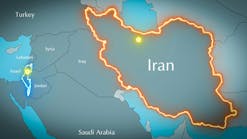Downstream concerns highlight the week's developments.
Refiner/marketers grapple with fiscal and environmental woes while petrochemical producers enjoy strong demand for their products.
Things are bound to get better for U.S. refiners in 1996 after a dismal 1995. Wholesale refining margins on the U.S. Gulf Coast averaged 10/bbl in 1995, says Wright Killen (WK), Houston. This compares with about $1/bbl for 1994 and makes 1995 the worst year for Gulf Coast refiners since 1987.
"Compressed light to heavy crude oil price differentials during the year limited the margin advantages that high conversion Gulf Coast refiners typically enjoy," said WK's Jim Dudley. Midcontinent margins were buoyed at about $2/bbl, due to attractive Canadian crude prices and strong regional demand.
"Supply/demand fundamentals appear favorable for at least some improvement in refining margins in 1996," said Dudley.
The U.S. has appealed a World Trade Organization finding that an EPA rule discriminated against gasoline imported from Venezuela and Brazil.
In January, a WTO panel ruled in favor of the two countries, saying the EPA rule was discriminatory because it subjected their gasoline exports to standards different from those for domestic gasoline (OGJ, Jan. 22, Newsletter).
U.S. Trade Representative Mickey Kantor said, "The results of this dispute will not and cannot compromise the Clinton administration's commitment to our environmental laws, nor will this matter undermine our fulfilling the objectives of the Clean Air Act.'' The National Defense Council Foundation says exempting foreign refiners from EPA rules would subject U.S. refiners to unfair competition.
A proposed new tax on undyed kerosine is drawing fire from U.S. petroleum marketers. Petroleum Marketers Association of America (PMAA) strongly opposes a White House proposal to impose a tax of 24/gal on kerosine unless it is dyed by refiners. That option is unlikely because of the added expense of installing dyeing facilities at refineries, PMAA says. It notes kerosine is used in the winter as a blendstock for home heating oil and diesel fuel to keep those products from solidifying prior to fueling. The level of kerosine varies, depending on weather, but in extreme cold, as much as half the finished product could be kerosine. "This means that many heating oil consumers may be paying a 12/gal federal tax on the fuel used to heat their homes during the coldest part of the winter," said PMAA. In addition, all off highway diesel or diesel used by state and local governments would be subject to the same tax, PMAA notes.
The risk posed by leaks from U.S. underground petroleum storage tanks (USTs) may be vastly overstated, concludes a major study by Lawrence Livermore National Laboratory and the University of California at Berkeley under a contract with the California State Water Resources Control Board funded in part by EPA. Those findings call into question the need for some of the stringent standards imposed by the federal government and by many states, says PMAA.
Study results prompted California Gov. Pete Wilson to order a halt to UST cleanups in that state for sites more than 250 ft from drinking water supplies.
Among its findings: The environmental harm from UST leaks is not nearly as severe as once thought; UST leaks rarely jeopardize drinking water; fuel hydrocarbons have limited effects on health, the environment, or California's groundwater resources; and cleanup directives are at odds with knowledge and experience gained from previous cleanups.
Chem Systems Inc. predicts global ethylene demand will grow at an average 4.9%/year through 2000. East Asia will generate 30% of increased consumption and an even larger share of the expected 27 million metric ton/year capacity expansion. Despite these additions, operating rates should remain at 90% for the period. Chem Systems projects similar expansion for other basic petrochemicals. Global demand growth through 2000 is pegged at 5.4%/year for propylene and 4%/year for benzene.
Joint ventures in Europe's petrochemical industry are becoming more common. Shell Chemicals Europe and BASF soon will disclose the European site for a planned 50-50 venture styrene monomer/propylene oxide (SM/PO) plant.
The $580 million plant, to start up in 1999, will have capacities of 550,000 metric tons/year of SM and 250,000 tons/year of PO. Shell has been planning for some time further investment in PO capacity in response to unabated growth in demand by producers of polyols, polyesters, and solvents.
Amoco is setting a high target for operating results the rest of the decade. Chairman Lawrence H. Fuller says the company aims to increase worldwide oil and gas production 25% by 2000 to 1.725 million bbl of oil equivalent (BOE)/day, while replacing more than 100% of production each year. Most of the gain will come from projects outside North America, which are expected to increase output 35% by 2000. Amoco's North American gas production could rise to 4.2 bcfd from 3.3 bcfd. Amoco pegs 1996 capital spending of $1.25 billion on chemicals-up from $470 million in 1994 and $860 million in 1995-with the objective of generating $10 billion of revenue in 2002. Since restructuring in 1994, Amoco has cut costs by about $1 billion/year.
The value of U.S. oil and gas assets bought and sold in 1995 is estimated at $5-7 billion, well within the range of activity in the 1990s.
So says Randall & Dewey, Houston, despite the anomaly in fourth quarter 1995 when the value of 157 deals disclosed in the U.S. totaled only $900 million, the lowest such quarterly total since first quarter 1993. For the year, 502 such deals were valued at $6.4 billion with an average acquisition cost of $4.54/BOE, down from $4.93/BOE in 1994. Independents last year led other industry sectors, accounting for 47% of the properties sold and 46% of the properties acquired, for a net acquisition value of $531 million. Integrated companies in the U.S. in 1995 reported net divestitures worth more than $1 billion.
The House commerce committee staff has circulated a proposed Superfund reauthorization bill, hoping to get the stalled legislation moving.
The bill by Rep. Michael Oxley (R-Ohio) drops a controversial provision that would allow companies cleaning waste dumps a 50% rebate on their cleanup costs. But the bill would not impose retroactive liability, which requires firms to clean sites they own no matter who was responsible for the pollution.
Alberta is bracing to fight a possible increase in resource taxes by Ottawa in a federal budget scheduled for April.
There have been unofficial reports Ottawa is considering changes in resource taxes to take an extra $40-100 million (Canadian)/year.
Alberta Premier Ralph Klein says the province will fight any "cash grab" on oil and gas revenues. However, Klein contends the tax change is only one of a number of options Ottawa is eyeing, and he is not convinced the government plans to hit resource revenues.
Alberta Energy Minister Pat Black says industry officials have been alerted to prepare counterproposals to any change in resource allowances for petroleum companies. The mining industry also plans to fight any changes. Black says Ottawa's data show some junior and intermediate gas and mining firms could be hit with a 17% tax hike.
While Conoco has beaten British Gas-chief interest holder in the Interconnector project linking U.K. gas supplies with continental Europe-to the first supply contract tied to Interconnector (see Industry Briefs, p. 32), news for the U.K.'s former gas monopolist has not been all bad.
BG recently disclosed plans to split into two companies, with the smaller firm to be assigned long term gas purchase contracts under which BG stands to lose about $2.25 billion (OGJ, Feb. 12, p. 33). BG's main gas suppliers BP and Shell Expro-the North Sea operating combine of Shell and Esso-have refused to negotiate a cut in gas prices. But the expected short life of the smaller BG offspring, British Gas Energy, seems to have brought Shell Expro and BP back to the table. Shell says it and Esso are ready to negotiate with BG to try to find "a commercial solution to the problem." BP has held preliminary talks with BG, saying, "It is hard to predict an outcome" to the dispute.
BP plans to jump capacity of its Forties oil pipeline by 15% to handle output from the Eastern Trough Area Project (ETAP) and other future Central North Sea developments.
Projects costing a total $32 million are planned to hike system capacity by 150,000 b/d to 1.15 million b/d by October. They include debottlenecking hydraulic systems at Kinneil terminal's third process train, which came on stream in 1994; debottlenecking gas processing plants on all three of Kinneil's process trains; installation of a crude blender at Grangemouth refinery; and conversion of a spare flow tank at Kinneil into a buffer storage unit.
This follows a number of expansions to Forties export facilities (OGJ, Aug. 30, 1993, p. 49). The system now handles 40% of U.K. offshore oil output.
ETAP consists of seven fields operated by BP and Shell Expro to be developed under a $2.4 billion program, with output to begin in second half 1998 and peak at 210,000 b/d of oil and 360 MMcfd of gas (OGJ, Jan. 22, p. 21).
Copyright 1996 Oil & Gas Journal. All Rights Reserved.

